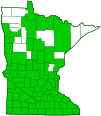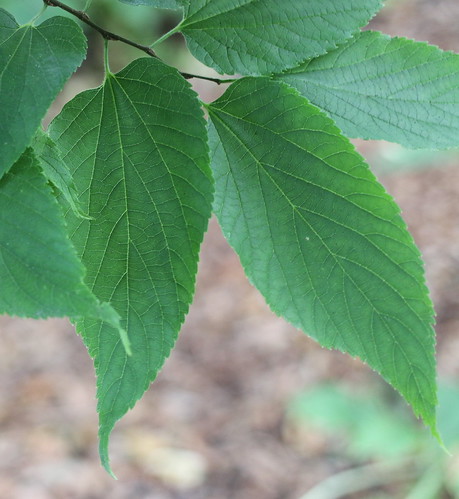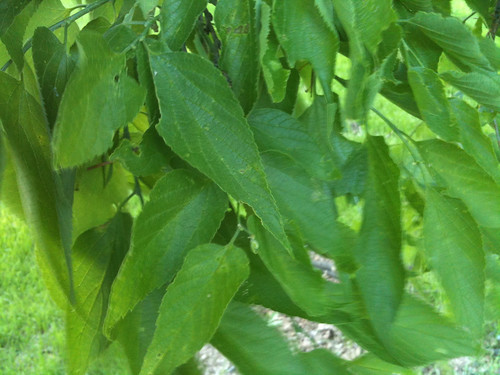northern hackberry
(Celtis occidentalis)
Conservation • Wetland • Description • Habitat • Ecology • Use • Distribution • Taxonomy
Description |
||
Northern hackberry is a medium to large, moderately fast-growing, deciduous tree. In Minnesota mature trees are usually 40′ to 60′ tall and 10″ in 16″ in diameter at breast height. Large individuals can reach up to 75′ in height and 56″ in diameter. It is moderately long-lived, often reaching between 150 and 200 years in age. It has a deep, fibrous root system that, where conditions permit, may be10 to 20 feet deep. It has no taproot. It is usually found as scattered individuals in river terraces and floodplains, but it can persist when planted (by humans or birds) in dry upland areas. The trunk is slender and usually divided near the base of the crown into a few large, upright, spreading limbs. On older trees the trunk is significantly flared at the base where it joins the surface roots. The branches are gracefully spreading and sometimes slightly drooping at the ends. Young trees have an oval crown. Older trees have a spreading, irregularly rounded crown. The bark on young trees is thin, smooth, and light grayish-brown. It soon develops warty raised knobs, which develop into narrow, vertical, wavy, corky ridges as the tree ages. The wing-like ridges on otherwise smooth bark is a unique identifying feature of this tree. As the tree matures the ridges become flattened and more closely spaced and the bark becomes scaly. First-year twigs are slender, slightly zigzagged, green becoming tinged with brown, and usually hairy. Second-year twigs are brown and hairless. Leaf scars are U-shaped to semicircular and have three dot-like bundle scars. The pith is white and is finely chambered, at least at the leaf nodes. Lateral buds are reddish-brown, egg-shaped, flattened, pointed, ¼″ to 5 ⁄16″ long, and closely appressed to the twig. There is no true terminal bud, but the lateral bud at the end of the twig is often bent sideways. The leaves are deciduous, alternate, and unlobed. They and are attached to the twig on a slender, hairy, ¼″ to ⅝″ long leaf stalk. The blades are leathery, egg-shaped to lance-shaped, 2⅜″ to 4¾″ long, and 1 3 ⁄16″ to 2¼″ wide. They taper gradually to a long, drawn out point at the tip with concave sides along the tip. The base is asymmetrical, rounded or somewhat heart-shaped. The upper surface is dark green and may be either mostly hairless or covered with short, straight hairs. The lower surface is pale green and hairy along the veins. The margins are toothed from the tip to well below the middle but not near the base. There are 10 to 40 sharp, forward pointing teeth per side. There are three main veins, one midrib and a pair of veins that originate just below the base of the blade, and 4 or 5 lateral veins per side that originate at at intervals along the midrib. The leaves turn light yellow in the fall. Flowers appear in late April to late May. Male and female flowers are borne on the same first-year brachlet of the same tree. Male flowers appear on 1 ⁄16″ to ¼″ long stalks in small clusters at the base of the twig. Each male flower has 4 or 5 greenish or yellowish sepals, no petals, and 5 or 6 stamens on white filaments. Female flowers appear on ⅛″ to ⅜″ long stalks singly or in pairs in a leaf axil of the twig. Each female flower has 4 or 5 greenish or yellowish sepals, no petals, and 2 stigmas that are bent backward. The flowers are pollinated by the wind The fruit is a fleshy, relatively dry drupe with a single pitted stone. It is spherical, ¼″ to ½″ in diameter, and is tipped with the remnants of the style. It is green at first, turning dull reddish-purple and often wrinkled at maturity. It matures in August to late September and remains on the tree until eaten by a bird. |
||
Height |
||
40′ to 60′ |
||
Record |
||
The champion northern hackberry in Minnesota is on private property near Janesville, in Waseca County. In 2018 it was measured at 84′ tall and 173″ in circumference (55″ in diameter), with a crown spread of 50′. |
||
Flower Color |
||
Green |
||
Similar Species |
||
Habitat |
||
Moist; river terraces, floodplains; moderately shade tolerant when young. |
||
Ecology |
||
Flowering |
||
Late April to late May |
||
Pests and Diseases |
||
hackberry nipple gall maker (Pachypsylla celtidismamma) hackberry witches’ broom mite (Eriophes celtis) |
||
Use |
||
|
||
Distribution |
||||
|
Sources |
|||
| 5/22/2023 | ||||
Nativity |
||||
Native |
||||
Occurrence |
||||
Common |
||||
Taxonomy |
|||
| Kingdom | Plantae (green algae and land plants) | ||
| Subkingdom | Viridiplantae (green plants) | ||
| Infrakingdom | Streptophyta (land plants and green algae) | ||
| Superdivision | Embryophyta (land plants) | ||
| Division | Tracheophyta (vascular plants) | ||
| Subdivision | Spermatophytina (seed plants) / Angiospermae (flowering plants) | ||
| Class | Magnoliopsida (flowering plants) | ||
| Superorder | Rosanae | ||
Order |
Rosales (roses, elms, figs, and allies) | ||
Family |
Cannabaceae (hackberry) | ||
Genus |
Celtis (hackberries) | ||
The genus Celtis was formerly placed in the family Ulmus (elms). A molecular phylogenetic study in 2002 caused a reordering of families in the order Rosales. As a result, this genus is now grouped with hemp and hops in the family Cannabaceae. The leading sources for taxonomic ranking, including ITIS, NCBI, GRIN, and The Plant List reflect this change. Most botanical sources, including PLANTS and Flora of North America (FNA), do not. |
|||
Subordinate Taxa |
|||
|
|||
Synonyms |
|||
|
|||
Common Names |
|||
common hackberry hackberry northern hackberry |
|||
Glossary
Stigma
In plants, the portion of the female part of the flower that is receptive to pollen. In Odonata and Hymenoptera, a blood-filled blister or dark spot at the leading edge of each wing toward the tip, thought to dampen wing vibrations and signal mates. In Lepidoptera, an area of specialized scent scales on the forewing of some skippers, hairstreaks, and moths.
Visitor Photos |
|||||
Share your photo of this plant. |
|||||
| This button not working for you? Simply email us at info@MinnesotaSeasons.com. Attach one or more photos and, if you like, a caption. |
|||||
Randy |
|||||
Fruit of a northern hackberry, Freeborn County, MN, July 2017 |
|||||
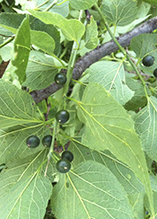 |
|||||
Northern hackberry, Freeborn County, MN, July 2017. They can get quite large |
|||||
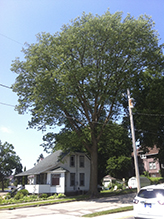 |
|||||
Young northern hackberry |
|||||
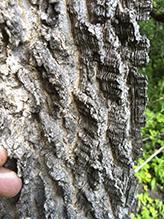 |
|||||
Middle aged northern hackberry |
|||||
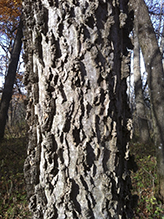 |
|||||
Older northern hackberry |
|||||
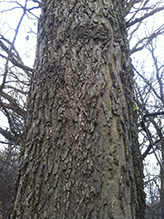 |
|||||
Northern hackberry trunk |
|||||
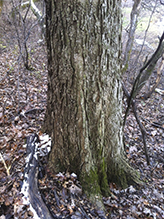 |
|||||
Open grown northern hackberry, showing strong branching form, Freeborn County, MN, December 2016. Makes a splendid shade tree. |
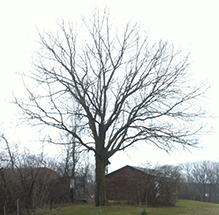 |
||||
MinnesotaSeasons.com Photos |
|||||
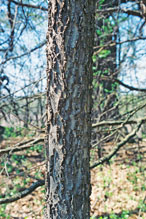 |
|||||

Visitor Videos |
|||
Share your video of this plant. |
|||
| This button not working for you? Simply email us at info@MinnesotaSeasons.com. Attach a video, a YouTube link, or a cloud storage link. |
|||
Other Videos |
|||
| How To Identify Hackberry Tree - Wild Edible Berries MiWilderness |
|||
About
Published on Nov 2, 2013 How to identify hackberry tree. Wild edible berries are abundant, taste great, and are good for health. Hackberry trees, Celtis occidentalis, can be found throughout most of North America. Close relatives of hackberry, such as sugarberry, Celtis laevigata, and Celtis australis can be found in other parts of North America and throughout the world. The entire hackberry fruit is considered edible and can be ground as seasoning, made into hackberry milk, eaten raw as a whole food, or the thin sweet berry can be removed from the seed or nut and prepared into jams, jellies, fruit leather, etc. Hackberries are high in protein, fat and carbohydrates, the three essential nutrients for survival, Hackberries are a great source of calcium, phosphorus and other micro-nutrients. Potentially a great winter survival super food, hackberries ripen in September and October lasting on the tree into winter, or even spring in some situations. Hackberry is in the elm family, recently placed in the hemp family along with Cannabis, and has medicinal properties similar to that of other elm species. A hackberry bark decoction was used to treat sore throats and an extraction of the wood was used to treat venereal disease. Hackberry wood is quite hard and was used for fencing and cheap furniture. Hackberry wood seems a bit springy to me, similar to hickory, and may possibly be used to make primitive bow staves. Visit me on Facebook https://www.facebook.com/michigan.wilderness Thanks for watching, commenting, subscribing to, and supporting this channel. If you like this video please give a thumbs up and share it with others. If you have any questions or tips please leave a comment. |
|||
| Trees with Don Leopold - hackberry ESFTV |
|||
About
Uploaded on Oct 10, 2011 No description available. |
|||

Visitor Sightings |
|||||
Report a sighting of this plant. |
|||||
| This button not working for you? Simply email us at info@MinnesotaSeasons.com. Be sure to include a location. |
|||||
| Randy July, 2017 |
Location: Freeborn County, MN They can get quite large |
 |
|||
| Randy December, 2016 |
Location: Freeborn County, MN Middle aged northern hackberry |
 |
|||
MinnesotaSeasons.com Sightings |
|||||
Beaver Creek Valley State Park Bertram Chain of Lakes Regional Park Carpenter St. Croix Valley Nature Center Carver Highlands WMA, South Unit Clifton E. French Regional Park Clinton Falls Dwarf Trout Lily SNA Forestville/Mystery Cave State Park John Peter Hoffman Spring Brook Valley WMA Minnesota Valley NWR, Chaska Unit Minnesota Valley State Recreation Area, Lawrence Unit P.N. and G.M. Nelson Wildlife Sanctuary Prairie Creek WMA, Koester Prairie Unit Robert Ney Memorial Park Reserve Stanley Eddy Memorial Park Reserve |
|||||

|
Created: Last Updated: © MinnesotaSeasons.com. All rights reserved. |
